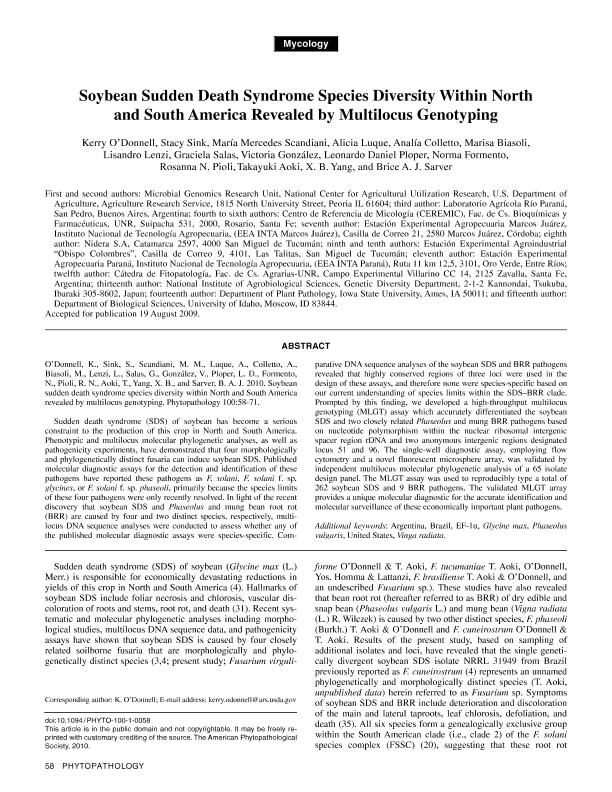Mostrar el registro sencillo del ítem
dc.contributor.author
O'Donnell, Kerry
dc.contributor.author
Sink, Stacy
dc.contributor.author
Scandiani, María Mercedes

dc.contributor.author
Luque, Alicia
dc.contributor.author
Colletto, Analía
dc.contributor.author
Biasoli, Marisa
dc.contributor.author
Lenzi, Lisandro
dc.contributor.author
Salas, Graciela
dc.contributor.author
González, Victoria
dc.contributor.author
Ploper, Leonardo Daniel

dc.contributor.author
Formento, Norma
dc.contributor.author
Pioli, Rosanna Nora

dc.contributor.author
Aoki, Takayuki
dc.contributor.author
Yang, X. B.
dc.contributor.author
Sarver, Brice A. J.
dc.date.available
2019-05-02T20:10:32Z
dc.date.issued
2010-01
dc.identifier.citation
O'Donnell, Kerry; Sink, Stacy; Scandiani, María Mercedes; Luque, Alicia; Colletto, Analía; et al.; Soybean sudden death syndrome species diversity within North and South America revealed by multilocus genotyping; American Phytopathological Society; Phytopathology; 100; 1; 1-2010; 58-71
dc.identifier.issn
0031-949X
dc.identifier.uri
http://hdl.handle.net/11336/75454
dc.description.abstract
Sudden death syndrome (SDS) of soybean has become a serious constraint to the production of this crop in North and South America. Phenotypic and multilocus molecular phylogenetic analyses, as well as pathogenicity experiments, have demonstrated that four morphologically and phylogenetically distinct fusaria can induce soybean SDS. Published molecular diagnostic assays for the detection and identification of these pathogens have reported these pathogens as F. solani, F. solani f. sp. glycines, or F. solani f. sp. phaseoli, primarily because the species limits of these four pathogens were only recently resolved. In light of the recent discovery that soybean SDS and Phaseolus and mung bean root rot (BRR) are caused by four and two distinct species, respectively, multilocus DNA sequence analyses were conducted to assess whether any of the published molecular diagnostic assays were species-specific. Comparative DNA sequence analyses of the soybean SDS and BRR pathogens revealed that highly conserved regions of three loci were used in the design of these assays, and therefore none were species-specific based on our current understanding of species limits within the SDS-BRR clade. Prompted by this finding, we developed a high-throughput multilocus genotyping (MLGT) assay which accurately differentiated the soybean SDS and two closely related Phaseolus and mung BRR pathogens based on nucleotide polymorphism within the nuclear ribosomal intergenic spacer region rDNA and two anonymous intergenic regions designated locus 51 and 96. The single-well diagnostic assay, employing flow cytometry and a novel fluorescent microsphere array, was validated by independent multilocus molecular phylogenetic analysis of a 65 isolate design panel. The MLGT assay was used to reproducibly type a total of 262 soybean SDS and 9 BRR pathogens. The validated MLGT array provides a unique molecular diagnostic for the accurate identification and molecular surveillance of these economically important plant pathogens.
dc.format
application/pdf
dc.language.iso
eng
dc.publisher
American Phytopathological Society

dc.rights
info:eu-repo/semantics/openAccess
dc.rights.uri
https://creativecommons.org/licenses/by-nc-sa/2.5/ar/
dc.subject
Argentina
dc.subject
Brazil
dc.subject
Ef-1α
dc.subject
Glycine Max
dc.subject
Phaseolus Vulgaris
dc.subject
United States
dc.subject
Vinga Radiata
dc.subject.classification
Otras Biotecnología Agropecuaria

dc.subject.classification
Biotecnología Agropecuaria

dc.subject.classification
CIENCIAS AGRÍCOLAS

dc.title
Soybean sudden death syndrome species diversity within North and South America revealed by multilocus genotyping
dc.type
info:eu-repo/semantics/article
dc.type
info:ar-repo/semantics/artículo
dc.type
info:eu-repo/semantics/publishedVersion
dc.date.updated
2019-04-23T17:51:06Z
dc.identifier.eissn
1943-7684
dc.journal.volume
100
dc.journal.number
1
dc.journal.pagination
58-71
dc.journal.pais
Estados Unidos

dc.journal.ciudad
Nueva York
dc.description.fil
Fil: O'Donnell, Kerry. United States Department of Agriculture. Agriculture Research Service; Estados Unidos
dc.description.fil
Fil: Sink, Stacy. United States Department of Agriculture. Agriculture Research Service; Estados Unidos
dc.description.fil
Fil: Scandiani, María Mercedes. Laboratorio Agrícola Río Paraná; Argentina
dc.description.fil
Fil: Luque, Alicia. Universidad Nacional de Rosario. Facultad de Ciencias Bioquímicas y Farmacéuticas; Argentina
dc.description.fil
Fil: Colletto, Analía. Universidad Nacional de Rosario. Facultad de Ciencias Bioquímicas y Farmacéuticas; Argentina
dc.description.fil
Fil: Biasoli, Marisa. Universidad Nacional de Rosario. Facultad de Ciencias Bioquímicas y Farmacéuticas; Argentina
dc.description.fil
Fil: Lenzi, Lisandro. Instituto Nacional de Tecnología Agropecuaria. Centro Regional Córdoba. Estación Experimental Agropecuaria Marcos Juárez; Argentina
dc.description.fil
Fil: Salas, Graciela. Nidera S.A.; Argentina
dc.description.fil
Fil: González, Victoria. Gobierno de Tucumán. Ministerio de Desarrollo Productivo. Estación Experimental Agroindustrial Obispo Colombres; Argentina
dc.description.fil
Fil: Ploper, Leonardo Daniel. Consejo Nacional de Investigaciones Científicas y Técnicas. Centro Científico Tecnológico Conicet - Tucumán; Argentina. Gobierno de Tucumán. Ministerio de Desarrollo Productivo. Estación Experimental Agroindustrial Obispo Colombres; Argentina
dc.description.fil
Fil: Formento, Norma. Instituto Nacional de Tecnología Agropecuaria. Centro Regional Entre Ríos. Estación Experimental Agropecuaria Paraná; Argentina
dc.description.fil
Fil: Pioli, Rosanna Nora. Universidad Nacional de Rosario. Facultad de Ciencias Agrarias; Argentina
dc.description.fil
Fil: Aoki, Takayuki. National Institute of Agrobiological Sciences. Genetic Diversity Department; Japón
dc.description.fil
Fil: Yang, X. B.. Iowa State University. Department of Plant Pathology; Estados Unidos
dc.description.fil
Fil: Sarver, Brice A. J.. University of Idaho. Department of Biological Sciences; Rusia
dc.journal.title
Phytopathology

dc.relation.alternativeid
info:eu-repo/semantics/altIdentifier/doi/https://dx.doi.org/10.1094/PHYTO-100-1-0058
dc.relation.alternativeid
info:eu-repo/semantics/altIdentifier/url/https://apsjournals.apsnet.org/doi/10.1094/PHYTO-100-1-0058
Archivos asociados
